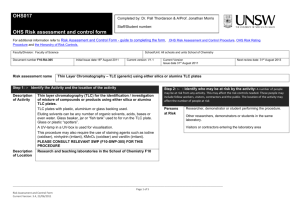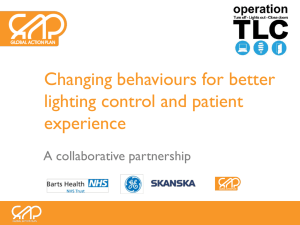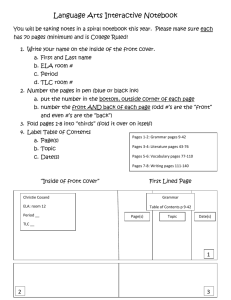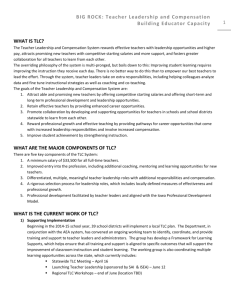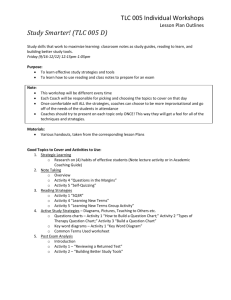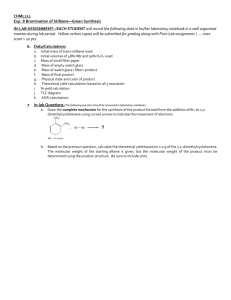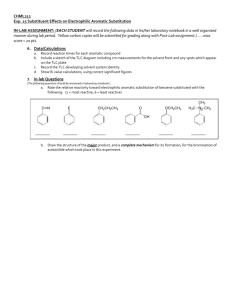SWP_ThinLayerChromatographyv4
advertisement
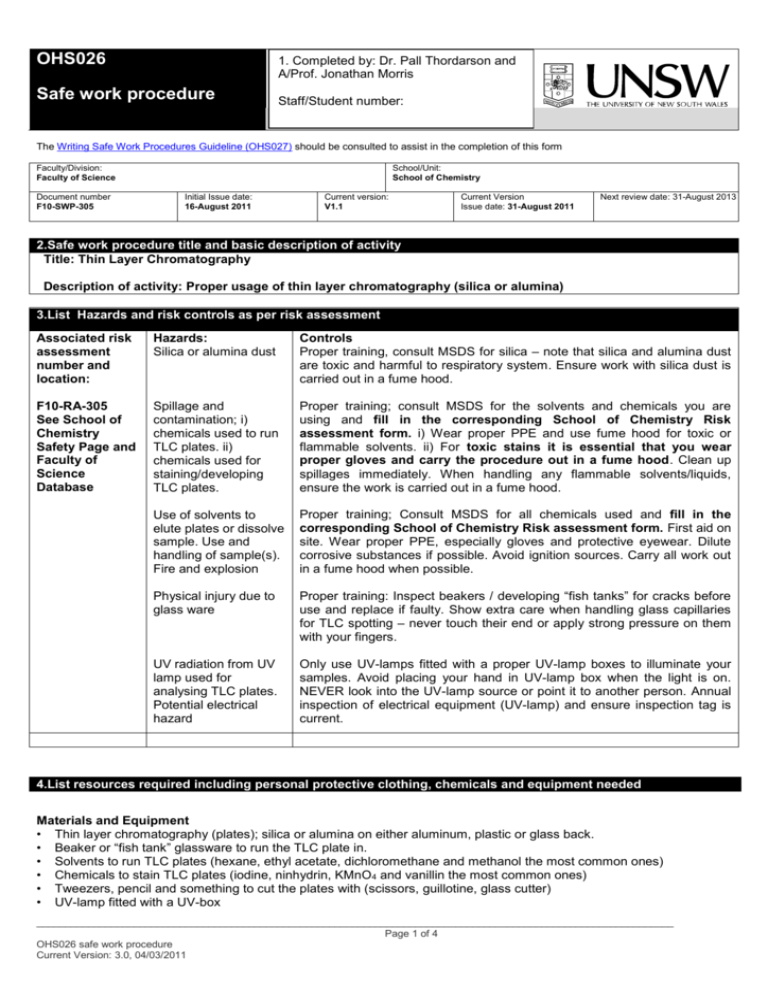
OHS026 1. Completed by: Dr. Pall Thordarson and A/Prof. Jonathan Morris Safe work procedure Staff/Student number: The Writing Safe Work Procedures Guideline (OHS027) should be consulted to assist in the completion of this form Faculty/Division: Faculty of Science Document number F10-SWP-305 School/Unit: School of Chemistry Initial Issue date: 16-August 2011 Current version: V1.1 Current Version Issue date: 31-August 2011 Next review date: 31-August 2013 2.Safe work procedure title and basic description of activity Title: Thin Layer Chromatography Description of activity: Proper usage of thin layer chromatography (silica or alumina) 3.List Hazards and risk controls as per risk assessment Associated risk assessment number and location: Hazards: Silica or alumina dust Controls Proper training, consult MSDS for silica – note that silica and alumina dust are toxic and harmful to respiratory system. Ensure work with silica dust is carried out in a fume hood. F10-RA-305 See School of Chemistry Safety Page and Faculty of Science Database Spillage and contamination; i) chemicals used to run TLC plates. ii) chemicals used for staining/developing TLC plates. Proper training; consult MSDS for the solvents and chemicals you are using and fill in the corresponding School of Chemistry Risk assessment form. i) Wear proper PPE and use fume hood for toxic or flammable solvents. ii) For toxic stains it is essential that you wear proper gloves and carry the procedure out in a fume hood. Clean up spillages immediately. When handling any flammable solvents/liquids, ensure the work is carried out in a fume hood. Use of solvents to elute plates or dissolve sample. Use and handling of sample(s). Fire and explosion Proper training; Consult MSDS for all chemicals used and fill in the corresponding School of Chemistry Risk assessment form. First aid on site. Wear proper PPE, especially gloves and protective eyewear. Dilute corrosive substances if possible. Avoid ignition sources. Carry all work out in a fume hood when possible. Physical injury due to glass ware Proper training: Inspect beakers / developing “fish tanks” for cracks before use and replace if faulty. Show extra care when handling glass capillaries for TLC spotting – never touch their end or apply strong pressure on them with your fingers. UV radiation from UV lamp used for analysing TLC plates. Potential electrical hazard Only use UV-lamps fitted with a proper UV-lamp boxes to illuminate your samples. Avoid placing your hand in UV-lamp box when the light is on. NEVER look into the UV-lamp source or point it to another person. Annual inspection of electrical equipment (UV-lamp) and ensure inspection tag is current. 4.List resources required including personal protective clothing, chemicals and equipment needed Materials and Equipment • Thin layer chromatography (plates); silica or alumina on either aluminum, plastic or glass back. • Beaker or “fish tank” glassware to run the TLC plate in. • Solvents to run TLC plates (hexane, ethyl acetate, dichloromethane and methanol the most common ones) • Chemicals to stain TLC plates (iodine, ninhydrin, KMnO 4 and vanillin the most common ones) • Tweezers, pencil and something to cut the plates with (scissors, guillotine, glass cutter) • UV-lamp fitted with a UV-box _______________________________________________________________________________________________________________ Page 1 of 4 OHS026 safe work procedure Current Version: 3.0, 04/03/2011 Personal Protective Clothing and Equipment • Protective safety glasses • Laboratory coat • Gloves (choose according to chemical compatibility and/or physical hazard) 5.List step by step instructions or order for undertaking the task How to run TLC (please also consult your supervisor) • Only suitably trained persons can do a TLC. • Cut up the TLC into the appropriate size. Use either scissors or a guillotine blade (if available and you been shown how to use it) for this with plastic or aluminium-backed TLC plates – ensure you don’t cut yourself doing this by avoiding any sharp blades. For glass-backed plate you it is ESSENTIAL that you are trained by someone with experience in this procedure before attending to do it on your own: Wear hand protection, preferably leather gloves. Use a glass-cutter to mark the plate. Then using two towels or similar soft clothing, hold with one hand on to each side of your mark and then break the glass across the mark by applying downwards pressure with both hands simultaneously. • Mark the “origin line” (Rf = 0) using a pencil (NOT A PEN!). This line is usually at least 5 mm from the bottom so that it will not be submerged in your running solvent once you place the TLC plate in the container you intend to run it in (see also below). Don’t make the line too thick as it might mask the spot where you apply your sample or damage the silica (or alumina). It is also a good idea to label with a pencil (1, 2..or A, B… or St, Rx, P…) underneath (not on it!) the position where you indent to spot your samples. • Prepare your sample(s) in a fume hood if the solvent or sample is toxic or flammable. Ensure the samples are diluted appropriately for your TLC analysis – if the sample(s) is too concentrated it will smear / streak, if it is too dilute it will not be visible. • To “spot” the sample you can use either small plastic tip for autopipettes (< 2.5 L tips for Eppendorfs are ideal), small prefabricated glass capillaries such as the ones used for melting point apparatus or make your own glass capillaries. If you use glass capillaries, ensure to take care not to touch the ends or apply so much pressure on them that they break. • Use either a beaker, a glass jar or a specially designed glass containers (“fish tanks”) to run your TLC in. If you are using flammable or toxic solvents, carry out this procedure in a fume hood. Fill your container to the appropriate level, usually only a few mm so that the origin line of your TLC will NOT be submerged. To aid with saturation of your TLC container, you can line the inside of your beaker/jar/fish tank with a filter paper. • Place your TLC plate in the container you are using to run it in and place a lid or a glass watch on top to keep it saturated. Ensure the origin line is not submerged. The solvent will now start to run up the TLC plate due to capillary action. • When the solvent is about 5-10 mm from the top it is time to stop the procedure. Ensure you are wearing gloves, open/remove the lid or watch glass and carefully remove the TLC plate using tweezers. Place the TLC plate on a clean surface in a fume hood while the solvents are drying off. • Once the TLC plate is dry, visualise in UV-box. NEVER look into the UV-light source. Wear gloves and avoid keeping your hands for long (< 30 s) inside the box with the UV-light on. It is a good idea to use a pencil marker to label around any visible spots. • If you need to stain your TLC plate, consult your supervisor for the correct procedure. Note that most of the chemicals used, including iodine, ninhydrin, KMnO4 and vanillin are irritants or oxidants and hence any staining procedures MUST be carried out in a fume hood. Ensure the stained TLC are completely dry before taking them out of the fume hood if necessary for visualisation / documentation. Use gloves at ALL TIMES when handling stained TLC plates. 6.List emergency shutdown procedures Turn off power at power point. If unable or unsafe to do so use the emergency cutoff switch (red button) for the laboratory (e.g., lF10-234) usually located on the wall near the entrance to the lab. 7.List Emergency procedures for how to deal with fires, spills or exposure to hazardous substances Contain the fire or spillage if safety of all personnel is not compromised, otherwise shutdown the power using the emergency cut-off switch (red button) for the laboratory (e.g.,, lF10-234) and call the security for emergency (x56666). 8.List Clean up and waste disposal requirements Consult MSDS and place any solvents or chemicals in the appropriate waste containers; non-halogenated solvents/chemicals in non-halogenated waste and halogenated solvents/chemicals in halogenated waste. Some laboratories have special waste-containers for commonly used staining agents such as ninhydrin _______________________________________________________________________________________________________________ Page 2 of 4 OHS026 safe work procedure Current Version: 3.0, 04/03/2011 Used silica or alumina plates can be disposed of with other solid silica/alumina waste in the appropriate waste containers. NEVER put used TLC places in domestic/general garbage bins. 9.List legislation used in the development of this SWP NSW OHS Act 2000, NSW OHS Regulation 2001, Code of Practice for the Labelling of Workplace Substances AS/NZS 2243.2:2006. Safety in laboratories. Part 2: Chemical aspects AS/NZS 2243.6-1990. Safety in laboratories. Part 6: Mechanical Aspects. AS/NZS 2243.3:2006 Safety in Laboratories Part 7 Electrical aspects AS/NZS 2161.1:2000 Occupational Protective Gloves – Selection, Use and Maintenance 10a.List competency required – qualifications, certificates, licensing, training - e.g. course or instruction: All personnel operating this equipment must have training and instructions on the safe use of the equipment and they must be assessed as competent. 10b. List competency of Assessor Academic supervisor, post-doctoral fellow or PhD student 11.Supervisory approval, And review Note: Local supervisor must determine appropriate authorisation and final sign off when this document is downloaded. Supervisor: Signature: Responsibility for SWP review: Date of review: 12.SWP Sign off sheet SWP name and version: In signing this section the assessor/ authorisor agrees that the following persons are competent in following this SWP Name Signature Date Competent Name of Assessor/Authoriser Assessor/Authoriser signature _______________________________________________________________________________________________________________ Page 3 of 4 OHS026 safe work procedure Current Version: 3.0, 04/03/2011 _______________________________________________________________________________________________________________ Page 4 of 4 OHS026 safe work procedure Current Version: 3.0, 04/03/2011


